In the latest Workshop Wednesday, held every Wednesday at 10 a.m. PST, Bo Borland, founder, and CEO of playbuilt, shares four steps for creating repeatable success at every stage of growth, specifically in B2B Enterprise. Prior to Playbuilt, Bo was SVP of Global Solutions Engineering at Mulesoft/Salesforce.
In startups, founders and teams often wear many hats — figuring out what to prioritize, developing and implementing all types of demand gen strategies, attending events and networking, and founder-led sales.
Let’s look at Borland’s approach to aligning and executing B2B team selling motions for a rinse-and-repeat process for growth.
Your Startup is in One of Four Stages
As a startup, you fall into one of four stages.
- Finding product market fit
- Moving from SMB to Enterprise or vice versa
- Achieving Enterprise repeatability
- Strategic expansion
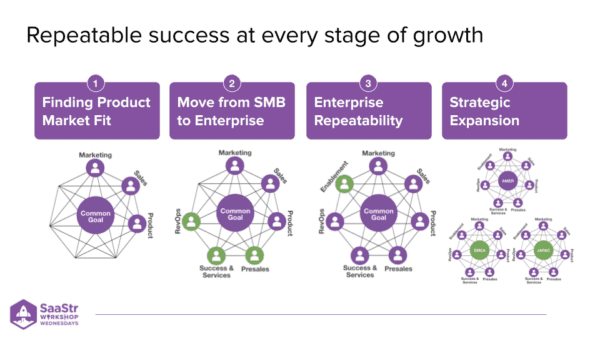
Borland has experienced all four stages at three different companies and knows what teams and functions look like for each stage of growth.
Finding Product Market Fit —
Typically has a marketing or sales leader, or you’re doing founder-led sales and product engineering and building.
Moving From SMB To Enterprise —
A combination of pre-sales like solution or sales engineering, customer success, and a more robust revenue ops function.
Achieving Enterprise Repeatability —
A revenue enablement team is critical for codifying success and using teaching methods to onboard and scale teams across your revenue functions during stage three.
Strategic Expansion —
When companies are expanding globally, launching new products, and acquiring other companies, every functional leader gets replicated across other theaters.
“Irregardless of the stage you’re in, success is about aligning GTM teams around a common goal of delivering repeatable customer value in a way that generates growth,” Borland says.
Step 1: Create A Teaming Mindset Around A Common Goal
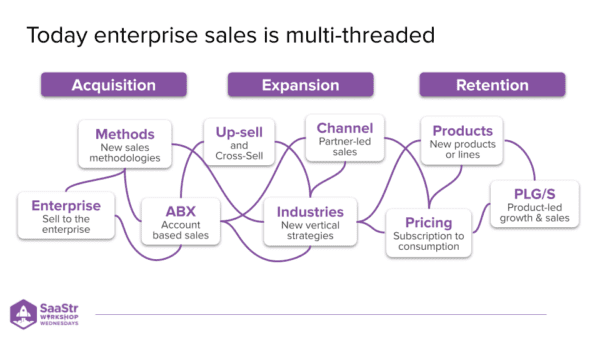
Teaming is the new selling as companies move towards integrating go-to-market focused on revenue and the shared goal of delivering repeatable customer value that generates growth.
Why is teaming the new selling?
Because Enterprise sales is a complex, multi-threaded beast — the days of the lone sales rep doing it all are over.
Today, SaaS companies employ specialists to run revenue plays across customer acquisition, expansion, and retention motions.
You can see in the diagram above that there are many examples of revenue plays, and as your company grows, it becomes even more multi-threaded.
Actions Required To Turn Your Pipeline Into Wins
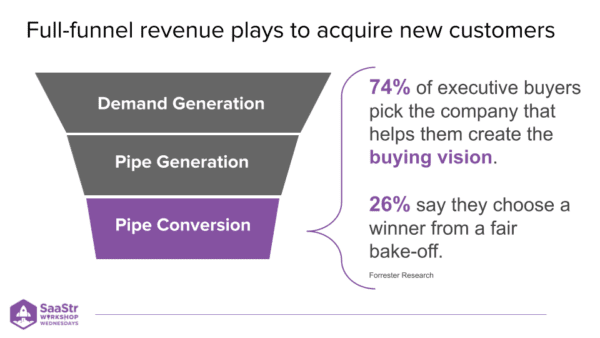
The acquisition motion in the above image shows a simplified three-stage view for acquiring customers.
- Demand generation — All about educating your target market on a problem and building trust and interest in your brand and solution.
- Pipe generation — Attracting your target market with active buying intent into your pipeline.
- Pipe conversion — All solutioning and commercials involved to turn your pipeline into wins.
There’s one problem when it comes to revenue teams…
GTM teams over-rotate on demand and pipe gen, and not enough GTM innovation is focused on pipeline conversion strategies.
Teams fail to consider the full cycle revenue play, especially for GTM with complex solutions where the action to win Enterprise deals includes items like:
- Larger buyer committees
- Higher expectations
- Tailored positioning
- Complex, lengthy pilots
- Advanced security
- Crafted buying vision
What Borland sees with account teams is a lack of intentionality.
As a result, they’re led by the customer, and they reactively invest thousands of hours into these actions within a single account without ever distilling all that work into a coherent and compelling buying vision.
Why Crafting A Buying Vision Is Important
According to Forrester Research, 74% of executive buyers pick the company that helps them create the buying vision.
They choose a company that helps them see the need to do something different.
The buying vision is a framework of tailored value messages that emerge over the sales cycle.
They’re designed to go viral inside the customer organization and drive uniqueness and urgency into that conversation.
“I believe this form of buyer enablement is table stakes in SaaS today,” Borland shares.
Step 2: Create Aha Moments and the Buying Vision Using The 9-Box Periodic Table
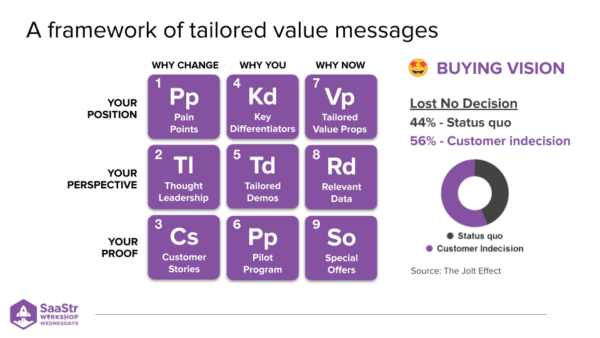
Recent research in the book The Jolt Effect showed that 56% of lost deals aren’t lost to the status quo but to customer indecision.
Buyers are not enabled or confident enough to pull the trigger on your solution because the decision risk is too high.
What can you do to change this?
Start with the 9-box periodic table.
This table considers the elements needed to craft a tailored buying vision.
It starts with recognizing that you have three levers to persuade your customer.
- Your position
- Your perspective
- Your proof
You have to persuade the buying committee on why they should change, why they should choose you, and why they need to buy now.
Pain Points (Pp)
- Starting with the top left box, you have the most basic positioning around “why change,” and it starts from a place of empathy for your buyers’ pains and needs.
Thought Leadership (Tl)
- The next perspective on “why change” is insights and expertise in the form of thought leadership.
Customer Stories (Cs)
- How do you think you can help them accomplish something and deliver proof initially? Through customer stories.
- If the buyer is engaged and leaning into your sales cycle, move into the second column.
Key Differentiators (Kd)
- Your position is to directly address the key differentiators and why your solution is the best. Your customers want to hear why you are different.
Tailored Demos (Td)
- You’ve learned enough now to deliver a very informed perspective with tailored demos about how your solution can uniquely deliver their specific use cases.
Pilot Program (Pp)
- If tailored demos go well, it’s time for your proof point in the form of a pilot program, a trial, or a workshop. That’s your proof.
- If you’ve made it this far with your customer, it’s time to move to your position in the final column.
Tailored Value Props (Vp)
- Your position is informed enough to craft highly tailored value propositions. These will be unique to each prospect. Of course, they’ll come from your value props, but phrase them so they uniquely address your customer’s objectives, use cases, needs, and pains.
Relevant Data (Rd)
- Your perspective should include relevant data — ROI and pilot results you read out during a presentation to a decision-making committee, for example.
Special Offers (So)
- The final element is the special offer. Use it to drive urgency during the why now phase.
- These elements come together to form a point-of-view and inform the buying vision. They’ll help you box out the competition and close more deals that would have been lost to customer indecision.
The Aha Moments
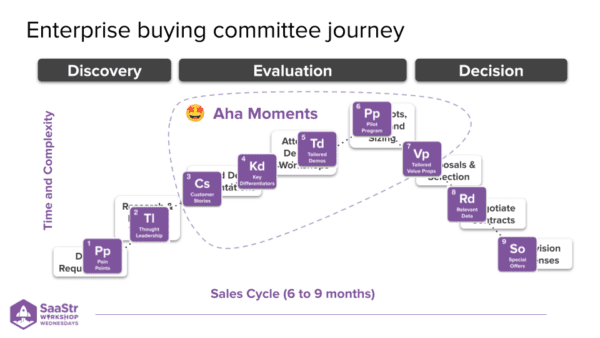
Those elements can be placed within the context of the full funnel buyer’s journey.
The journey covers three stages.
- Discovery
- Evaluation
- Decision
The buyer actions are plotted against the sales cycle duration on the x-axis, and the time and complexity or amount of time and investment from the vendor and customer is on the y-axis.
As we overlay 9-box on the buyer’s journey, it’s important to recognize the most intense and focused customer engagement occurs during the evaluation stage.
This is where the real magic happens—the aha moments.
Think of aha moments as inflection points. They determine whether the deal is won or lost.
When the buyer’s emotions are triggered, their eyes dilate, and they envision a better future with your solution.
These are clear turning points when prospects morph from skeptical buyer to vendor co-conspirator, helping you to win over the buying committee.
Step 3: Map 9-Box to the Buyer’s Journey and Team Roles
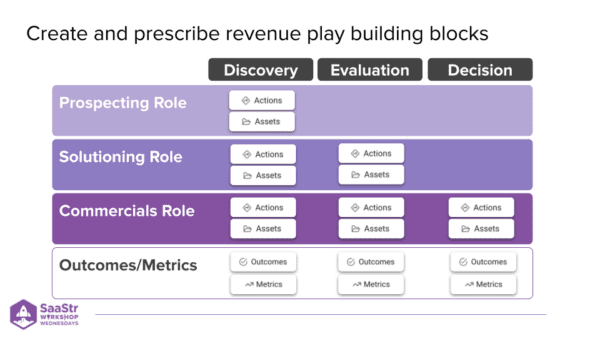
You want to look at how you can construct full cycle revenue plays by mapping 9-box to the buyer’s journey and relevant team roles.
You’ll need to define your business objectives for the revenue play first.
- What are we trying to achieve with this revenue play? Is it acquisition, expansion, or retention?
Collaborate with AEs and SEs and Customer Success to define what the gold standard is you’re trying to achieve with this play.
And not only that but how can you create a great customer and employee experience?
A key question to ask the team is:
- What roles, actions, narratives, assets, and enablement are needed to put this together?
Those things will be the essential building blocks for your revenue play.
Step 4: Translate and Use Those Building Blocks to Assemble Revenue Plays
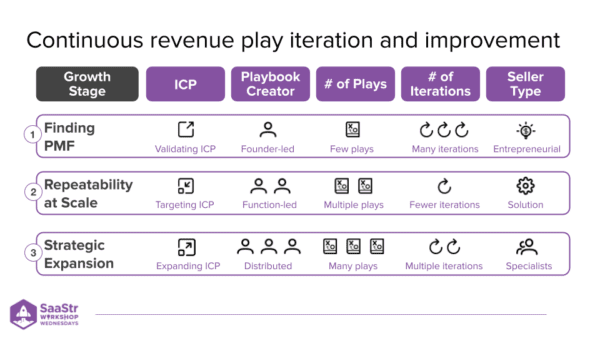
Now, the job is to create your inventory of revenue play building blocks.
Start by aligning with your team on the outcomes you’re trying to achieve at each stage.
For example, in the discovery phase, one of the shared outcomes could be to identify and qualify the buyer’s use case and tech stack.
You also want to define input and output metrics needed to measure the health and performance of the deal at each stage.
- Input metrics could be number of demos
- Output metrics could be conversion of those demos
Within each swim lane in the image above, you want to create well-defined actions that serve as a common language to ensure everyone speaks the same play page.
You’re building out these building blocks and informing these plays to:
- Create a rinse-and-repeat approach for aligning GTM functions
- Instill intentionality in your teams
- Gain agreement on what the gold standard is for what you’re trying to achieve
- Win more deals
- Create a great customer and employee experience.
Those are the basics of this approach to selling to B2B Enterprise customers in a repeatable way.
Key Takeaways
These revenue plays are not set in stone. You’ll continue to evolve, iterate, and improve them as you talk to customers, launch new features, and get new customer objections and use cases.
The goal is to give you a rinse-and-repeat approach to create success at any company growth stage.
The four steps are:
- Creating a teaming mindset around a common goal.
- Using 9-box to create aha moments and craft a buying vision.
- Mapping 9-box to the buyer’s journey and team roles.
- Translating and using those building blocks to assemble repeatable revenue plays.

